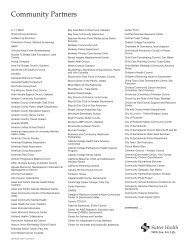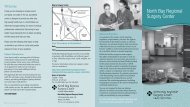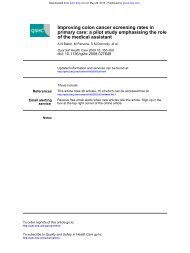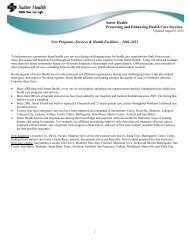Sutter Health Cancer Services and Programs
Sutter Health Cancer Services and Programs
Sutter Health Cancer Services and Programs
Create successful ePaper yourself
Turn your PDF publications into a flip-book with our unique Google optimized e-Paper software.
S t a t i s t i c a l O v e r v i e wOverview<strong>Sutter</strong> <strong>Health</strong> 2004 <strong>Cancer</strong> Registry DataThis overview presents an analysis of 8,139 new cases of cancer 1 diagnosed <strong>and</strong>/ortreated at the nine ACoS-accredited <strong>Sutter</strong> <strong>Health</strong> institutions during 2004. Thisrepresents a very small (2%) increase in systemwide volume over last year’s totals. 2PATIENT VOLUME BY CLASSOF CASE (Figure 1)Figure 1 shows the variability in thetotal number of cancer cases reportedin 2004 at each of the nine <strong>Sutter</strong> <strong>Health</strong>hospitals. Year 2004 overall case volumeranged from 359 at EMC to 1,937 atCPMC, for a total of 9,539 cases systemwide.Eighty-five percent of these cases(8,139) were newly diagnosed <strong>and</strong>/orreceived the first course of treatment atone of the nine <strong>Sutter</strong> centers. These aredesignated as “analytic” cases <strong>and</strong> allfurther analyses are restricted to thesedata.Figure 12004 <strong>Sutter</strong> <strong>Health</strong> Analytic <strong>Cancer</strong> CasesPatient Volume by class of CaseAGE AT DIAGNOSISOverallGenerally similar patterns were seen atall institutions, with the number of cancerpatients peaking in the 70–79 agerange. Almost 50% of cancer patientswere diagnosed in the 60–79 age range,<strong>and</strong> 83% were age 50 or over at thetime of diagnosis. The median age atdiagnosis was 65 years. The median ageranged from 62 (ABMC) to 71 (EMC).ABMC, SMCS <strong>and</strong> CPMC had theyoungest cancer patient populations,<strong>and</strong> EMC <strong>and</strong> MPHS had the oldest.These trends reflect differences in boththe underlying demographics of thecommunities served <strong>and</strong> the relativeincidence of the most prevalent cancersseen at each institution. The male cancerpatient population is slightly olderthan the female cancer patient population(median age is 67 vs. 64). Thesedata are consistent with those seen overthe last nine years in the <strong>Sutter</strong> <strong>Health</strong>cancer patient population.Eric Gold, Oncology Analyst/ProgrammerSee page two for abbreviations for<strong>Sutter</strong> <strong>Health</strong> institutions.1In order to be consistent with previous <strong>Sutter</strong> <strong>Health</strong><strong>Cancer</strong> <strong>Programs</strong> Annual Reports, which included onlymalignant neoplasms, this analysis does not includebenign neoplasms of the brain <strong>and</strong> central nervoussystem, which are reportable in the state of California,beginning with cases diagnosed Jan. 1, 2001, <strong>and</strong> later.However, these cases have been included in the primarysite tables for each facility at the end of this report.2It is important to note that hospital cancer registry datareflect patients diagnosed <strong>and</strong> treated in the hospital,unlike population-based cancer registry data such asthose reported by the California <strong>Cancer</strong> Registry <strong>and</strong> atthe SEER registry of the National <strong>Cancer</strong> Institute, whichrepresent all patients diagnosed in a defined population. 2005 Annual <strong>Cancer</strong> Center Report — 2004 Statistical Review | 33













